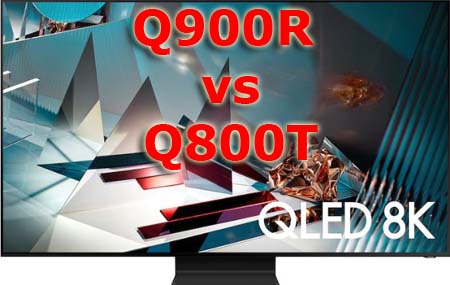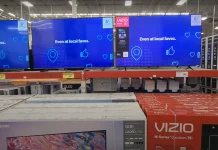Samsung began producing 8K TVs in 2018, with the first model, the Q900RA, launching that year. In 2019, the second-generation Q900RB model was introduced, and in 2020, the Q800T model took the spotlight. The 2018 and 2019 models were part of Samsung’s 9 Series, while the 2020 model belongs to the 8 Series. A detailed comparison of all parameters is provided in the table below, followed by a brief overview of the key differences between the TV models.
Model numbers may slightly vary depending on the region. For example, in the USA, Canada, and Mexico, the models are identified as QN65Q800TAFXZA, QN75Q800TAFXZA, and QN82Q800TAFXZA, while in Europe, the corresponding models are QE65Q800TXUX, QE75Q800TATXZA, and QE82Q800TATXZA. For simplicity, these TV models are commonly referred to as QN65Q800T, QN75Q800T, QN82Q800T (for the US and Canada) or QE65Q800T, QE75Q800T, QE82Q800T (for Europe), with the last letters denoting the generation, type of digital tuners, and country code.
A Brief Overview of the Differences Between Samsung 8K 2019 and 2020 TVs
| Q800T (2020) | Q900R (2019) | |
| screen | ||
| Screen Size | 65, 75, 82 | 55, 65,75, 82, 85, 98 |
| Style | Flat Panel | Flat Panel |
| Resolution | 7680 x 4320 | 7680 x 4320 |
| screen bit | 10bit | 10bit |
| type screnn | 8K | 8K |
| screen technology | MVA | VA |
| Backlighting | Direct Full Array 24X | Direct Full Array 16x |
| Dimming Technology | Ultimate 8K Dimming | Ultimate 8K Dimming |
| Stand Type (Color) | Bending Plate (Titan Black) | SIMPLE |
| Bezel Width | 4 Bezel-less | 3 Bezel-less |
| Video | ||
| Motion Rate | 240 | 240 |
| refresh rate | 120 | 120 |
| Color | 100% Color Volume with Quantum Dot | 100% Color Volume with Quantum Dot |
| HDR (High-Dynamic Range) | Quantum HDR 16X | Quantum HDR 24X |
| Picture Engine | Quantum Processor 8K | Quantum Processor 8K |
| Audio | ||
| Dolby | Yes | Yes |
| Sound Output | 70W | 60W |
| Woofer | Yes 2pics | Yes 2 pics |
| Speaker Type | 4.2.2CH | 4.2CH |
| Multiroom Link | Yes | Yes |
| Features | ||
| OS | Tizen | Tizen |
| Wi-Fi | Yes Wifi 5 | Yes Wifi 5 |
| Bluetooth | Yes (ver.4.2) | Yes (ver.4.2) |
| Smart Hub | Yes (incl. Universal Guide and TV Plus) | Yes (incl. Universal Guide and TV Plus) |
| Bixby | Yes | Yes |
| Digital Clean View | Yes | Yes |
| Ultra Black | No | No |
| ConnectShare | Yes | Yes |
| Closed Captioning | Yes | Yes |
| Game Mode | Yes | Yes |
| Eco Sensor | Yes | Yes |
| Mobile to TV – Mirroring, DLNA | Yes | Yes |
| TV to Mobile – Mirroring | Yes | Yes |
| Google Assistant | Yes | Yes |
| Alexa | Yes | Yes |
| AirPlay 2 | No | No |
| Auto Channel Search | Yes | Yes |
| InstaPort S (HDMI Quick Switch) | Yes | Yes |
| Channel Guide | Yes | Yes |
| Ambient Mode | Yes | No |
| Auto Power Off | Yes | Yes |
| AI Technology | Yes | Yes |
| Apps Platform | Smart TV Powered by TIZEN™ with Bixby Voice, Apps and Full Web Browser | Smart TV with Bixby Voice, Apps and Full Web Browser |
| Auto Motion Plus | Yes | Yes |
| Embedded POP | Yes | Yes |
| Anynet+ (HDMI-CEC) | Yes | Yes |
| V-Chip | Yes | Yes |
| USB HID Support | Yes | Yes |
| AI Upscale | 8K AI Upscaling | 8K AI Upscaling |
| Easy Pairing | No | No |
| Inputs & Outputs | ||
| HDMI | 4 (ver.2.0) | 4 |
| USB | 2 (ver 2.0) | 3 |
| Ethernet | Yes 100Mb/s | Yes |
| RF In (Terrestrial/Cable | Yes | Yes |
| RF In (Satellite Input) | No US, Yes Europe | No US, Yes Europe |
| Digital Audio Out (Optical)Yes | Yes | Yes |
| Audio Return Channel Support | Yes | Yes |
| One Connect | ? | Yes |
| Dimensions | ||
| Digital Broadcasting US | ATSC/ClearQAM | ATSC/ClearQAM |
| Digital Broadcasting Europe | DVB T/T2/C/S/S2 | DVB T/T2/C/S/S2 |
| Analog Tuner | Yes | Yes |
| Accessories | ||
| Remote control | QLED Standard Smart Remote (TM2050C) | TM1950C |
| Samsung OneRemote | Yes | Yes |
The most notable difference between the Q900R and Q800T models lies in the screen technology. The 2019 Q900R uses a VA (Vertical Alignment) matrix, while the 2020 Q800T is equipped with an MVA (Multi-domain Vertical Alignment) matrix. While these differences are technically notable, they are not significant enough to impact overall performance. In terms of dimming technology, the 65-inch and 75-inch Q800T models feature 24 dimming zones, while the 82-inch Q800T offers 32 zones. The Q900R, by comparison, had 16 zones. While these numbers sound impressive, they are primarily marketing terms and don’t directly correlate with actual performance improvements in terms of image quality.
The design has also undergone some changes. Notably, the Q800T features a new stand design, replacing the curved plate stand seen on the Q900R. Additionally, sound quality has been enhanced in the Q800T, which now includes six speakers and two subwoofers, offering improved surround sound support. However, the number of USB ports has been reduced—from three on the Q900R to just two on the Q800T.
Other parameters, such as display resolution and overall performance, have remained consistent. Samsung’s 8K TVs are known for their ultra-high-resolution screens, but it’s worth noting that they are primarily designed for upscaling lower-resolution content. Although the 8K resolution is a standout feature, the actual viewing experience may not be ideal for content that isn’t 8K natively, and viewing Full HD or lower resolution content on these TVs may not deliver the best image quality.






